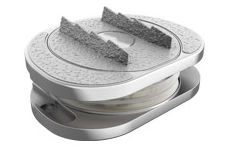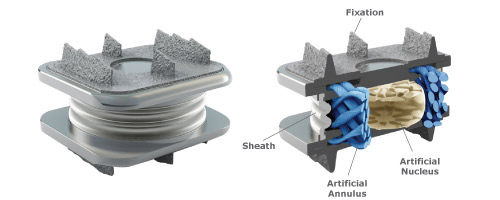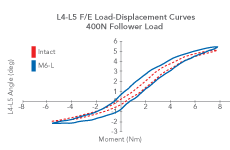Spinal Kinetics Quality of Motion
To eliminate friction, wear and excess motion the motion of a disc replacement should come from compression, not rotation. Quality of Motion is a combination of how the motion of a disc replacement replicates the motion of a healthy human disc and how long it lasts!
Quality of Motion is measured by how well the motion of an implanted functional disc replacement approximates the motion of a healthy disc over the entire range of motion, not just its endpoints.

How Did They Do It?
Through biomechanical testing, a load vs. angular displacement curve (“kinematic signature”) is generated that allows assessment of the Quality of Motion parameters.
Biomechanical testing with the M6 artificial disc replacement has demonstrated equivalent Quality of Motion compared to the healthy disc. The innovative artificial fiber annulus and nucleus construct of the M6 is the critical component in replicating this physiologic motion, as it is designed to provide the necessary restraint and control needed throughout the spine’s natural range of motion, while also avoiding friction and wear debris.

Quality of Motion through compression is achieved by replicating the natural components of healthy disc.
This requires both a natural acting disc Nucleus and a natural disc Annulus.
Artificial Nucleus
- Viscoelastic polymer designed to simulate native nucleus
- Allows physiologic axial compression
- Retained between endplates by fiber annulus matrix
- Designed to facilitate physiologic Center of Rotation (COR)

Artificial Annulus
- Ultra High Molecular Weight Polyethylene (UHMWPE) fiber material
- Intended to simulate native annulus and its performance characteristics
- Designed to provide controlled motion in all planes & axes of rotation
- Robust fiber matrix with multiple fiber layers similar to native annulus

What Do The Results Show?
The “kinematic signatures” of an intact human disc (red) and M6-L lumbar disc (blue) are nearly identical!
The M6-L lumbar disc maintained total ROM, vs. Intact , at 400N [9.4°±2.2° vs. 8.8°±1.1°, p=0.56], and at 800N [9.5°±2.1° vs. 8.4°±1.2°, p=0.32], with excellent Quality of Motion.
Patwardhan et al. Musculoskeletal Biomechanics Laboratory, Edward Hines Jr. VA Hospital, Hines, Illinois, USA.

We can now do multi-level ADR, lumbar and cervical artificial disc replacement, even fusion with disc replacement hybrid procedures. These solutions come without many of the complications involved with fusion surgery and early artificial disc replacement products, many still in use today.
Are you confused about what treatment is the best option for you?
